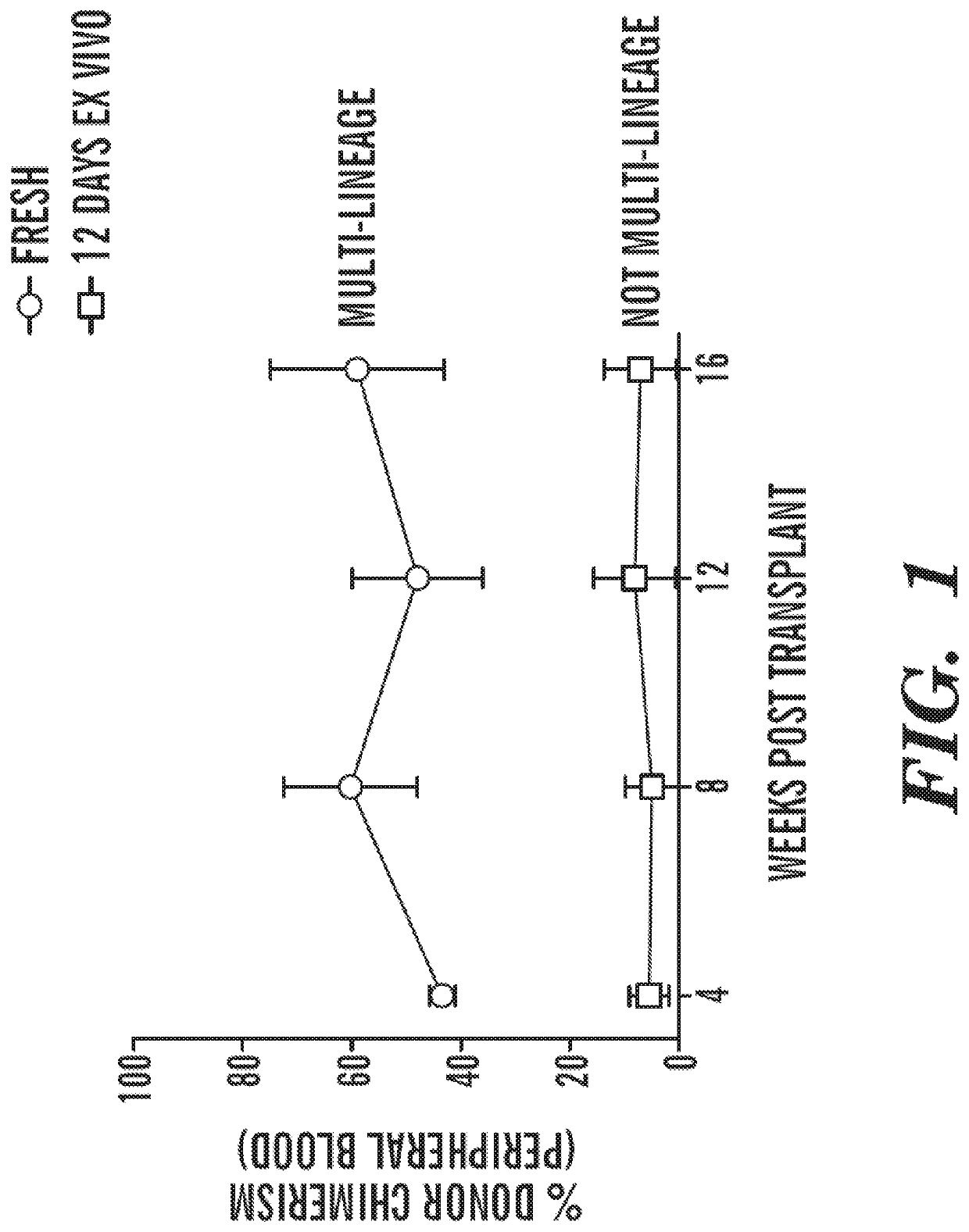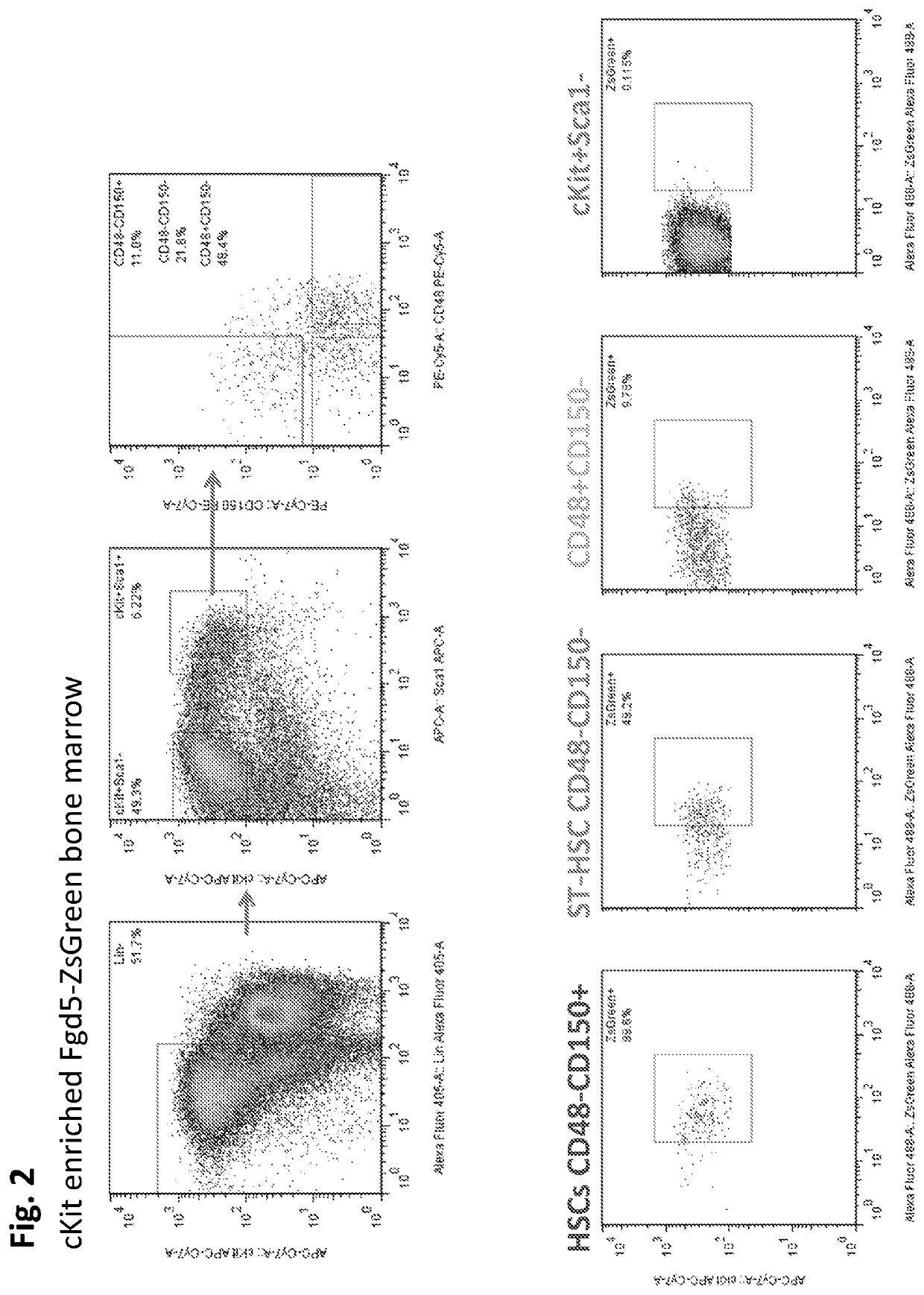Methods and compositions relating to hematopoietic stem cell expansion, enrichment, and maintenance
a technology compositions, applied in the field of compositions and methods for ex vivo expansion, enrichment, and maintenance of hematopoietic stem cells, can solve problems such as difficulty in obtaining sufficient numbers of these cells
- Summary
- Abstract
- Description
- Claims
- Application Information
AI Technical Summary
Benefits of technology
Problems solved by technology
Method used
Image
Examples
example 1
ecule Screens to Identify Combinations of Compounds that Expand, Enrich, and Maintain Cells with Hematopoietic Stem Cell Properties Upon Ex Vivo Culturing
[0850]FIG. 1 shows that HSC potential is rapidly lost upon culture. Peripheral bleed analysis following transplantation into lethally irradiated hosts of freshly isolated murine HSCs (Blue line, circles) or HSCs cultured for 12 days ex vivo in S-clone+IL12 / SCF / TPO+0.75% BSA (red line, squares). Various small molecule screens were conducted in order to determine optimal combinations of compounds that can be used to expand, enrich, and maintain the hematopoietic stem cell functional potential of hematopoietic stem cells. FIG. 4 shows a schematic representation of a small molecule screen for compounds that support HSC ex vivo maintenance and expansion. 1) Zs·Gr HSC reporter mouse marrow used to isolate HSCs (described in FIGS. 2 and 3A-3C). 2) Isolation of HSCs marked by ZsGr reporter. 3) Development of assay where hit is defined by t...
example 2
n of Histone Demethylation and TGFβ Signaling During Ex Vivo Culturing of HSCs Promotes Expansion, Enrichment, and Maintenance Cells with Hematopoietic Stem Cell Properties
[0851]An optimal combination of compounds that can be used to expand, enrich, and maintain the hematopoietic stem cell functional potential of hematopoietic stem cells includes a histone demethylase inhibitor and an inhibitor of the TGFβ receptor Alk5. FIG. 8 shows the ex vivo culture of 20 murine HSCs (LSK34-Flk2-150+ZsGr+) for 7 or 14 days in the presence of DMSO, LSD1 inhibitor IV (LS), Tgfbeta inhibitor (RepSox) or the combination of both (C2). Images taken at 4× magnification. Note that the cultures in the presence of C2 or LS are more homogenous and less differentiated. FIGS. 9A-9B show the expansion of phenotypic HSCs for 14 days ex vivo. 20 murine HSCs (LSK34-Flk2-150+ZsGr+) were cultured in the presence of DMSO, LSD1 inhibitor IV (LS), Tgfbeta inhibitor RepSox (RS), and the combination of both (C2) for 14...
example 3
ulturing HSCs in the Presence of HDAC Inhibitors Promotes Expansion, Enrichment, and Maintenance of Cells with Hematopoietic Stem Cell Properties
[0852]In addition to inhibitors of histone demethylation and TGFβ signaling, histone deacetylase inhibitors also promote the expansion, enrichment, and maintenance of hematopoietic stem cells ex vivo. FIGS. 22A-22B shows that structurally distinct HDAC inhibitors function equivalently to maintain immunophenotypic HSCs. 100 murine HSCs were cultured in the presence of cytokines only (SCF, TPO, and IL12) in the absence of compounds (Standard), or additionally supplemented with a cocktail of compounds (Lithium chloride, nicotinamide, N-acetylcysteine, ascorbic acid, A83-01, and SB203580) plus either valproic acid (VPA) or trichostatin A (TSA), which are structurally distinct HDAC inhibitors. FIG. 22A: Day 7 flow cytometric analysis and FIG. 22B: proportion of Fgd5-ZsGreen+Sca1+ cells for each replicate. FIGS. 41A-41C show that Romidepsin, a HD...
PUM
| Property | Measurement | Unit |
|---|---|---|
| size | aaaaa | aaaaa |
| compositions | aaaaa | aaaaa |
| conformational | aaaaa | aaaaa |
Abstract
Description
Claims
Application Information
 Login to View More
Login to View More - R&D
- Intellectual Property
- Life Sciences
- Materials
- Tech Scout
- Unparalleled Data Quality
- Higher Quality Content
- 60% Fewer Hallucinations
Browse by: Latest US Patents, China's latest patents, Technical Efficacy Thesaurus, Application Domain, Technology Topic, Popular Technical Reports.
© 2025 PatSnap. All rights reserved.Legal|Privacy policy|Modern Slavery Act Transparency Statement|Sitemap|About US| Contact US: help@patsnap.com



